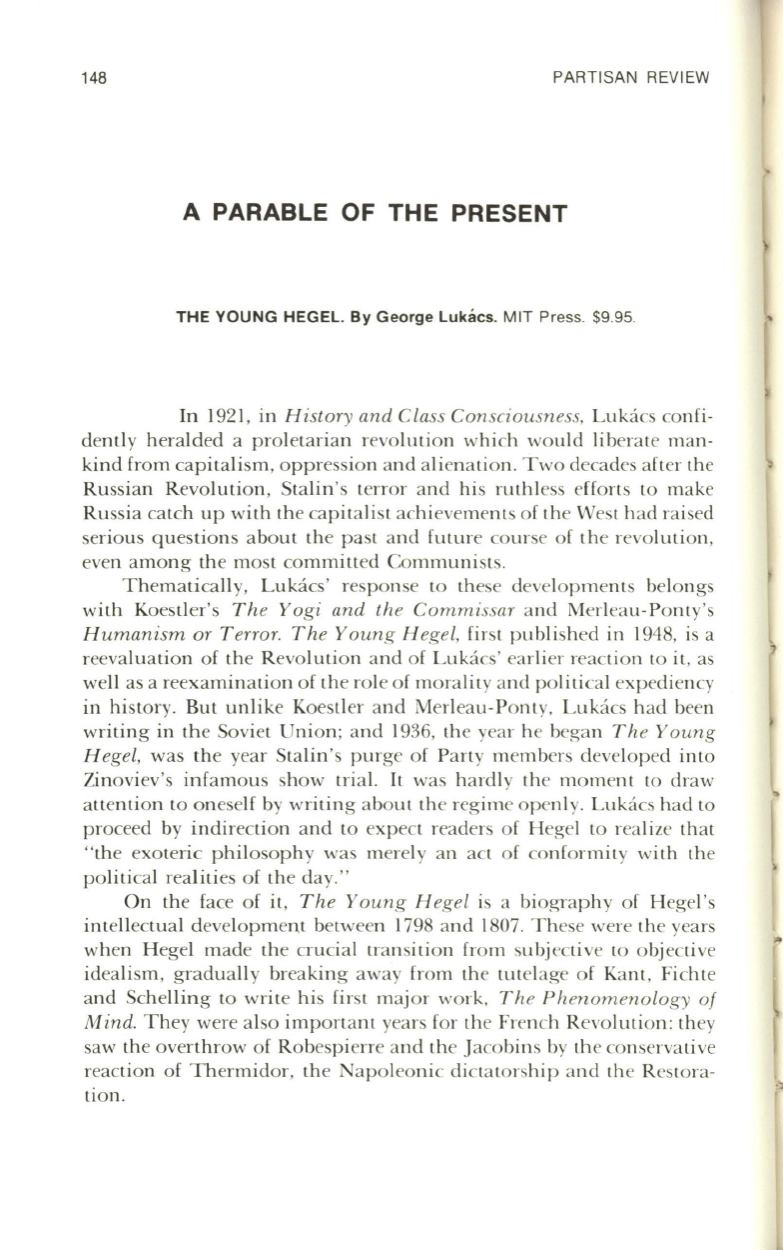
148
PARTISAN REVIEW
A PARABLE OF THE PRESENT
THE YOUNG HEGEL. By
George Lukacs. MIT Press. $9.95.
In 192 1, in
H istory and Class Consciousness,
Lukacs confi–
dentl y heralded a p roletari an revo luti on whi ch would liberate man–
kind from capitalism , oppress ion and a li ena ti on . Two decades after the
Ru ssian Revolution , Sta lin 's terror and hi s ruthl ess effo rts to ma ke
Russ ia ca tch up with the capita list achi evements of the Wes t had ra ised
serious ques ti on s a bout the past and future course o f the revolution ,
even among the mos t committed Communi sts.
Themati call y, Lukacs' response to these devel opments belongs
with Koestl er's
Th e Y ogi and th e Commissar
and Merl ea u-Po nty's
Humanism
or
T error. The Y oung H ege l,
fir st publi shed in 1948, is a
reeva lua tion of the Revo lution and of Lukacs' ea rli er reacti on to it, as
well as a reexamina ti on of the ro le of mo ra lity and po liti cal expedi ency
in hi story. But unlike Koestl er and Merl eau-Ponty, Lukacs had been
wri tin g in the Soviet Uni on ; and 1936, the year he began
Th e Y oung
H egel,
was the yea r Sta lin 's purge of Pa rty members d eveloped into
Zinovi ev' s infamou s show tri a l. It was hardl y the moment to draw
a ttenti on to oneself by writin g a bout th e regime openl y. Lu kacs had to
proceed by indirecti on and to expect readers of Hege l to rea li ze that
" the exo teri c philosophy was merely an act of conformity with the
political realiti es of the day."
On the fa ce of it,
Th e Young H ege l
is a biograph y o f Hegel's
intell ectua l development between 1798 and 1807. These were the yea rs
when Hegel made the crucia l transiti on from subj ective to o bj ecti ve
idea li sm , graduall y brea king away from the tutel age o f Kant , Fi chte
and Schelling
to
write hi s first majo r wo rk ,
Th e Phenomeno logy of
M ind.
They were a lso impo rtant yea rs fo r the French Revo lution: they
saw the overthrow of Ro bespierre and the J acobin s by th e conserva ti ve
reacti on of Thermido r, the Napo leoni c di ctato rship and th e Res to ra–
ti on .


